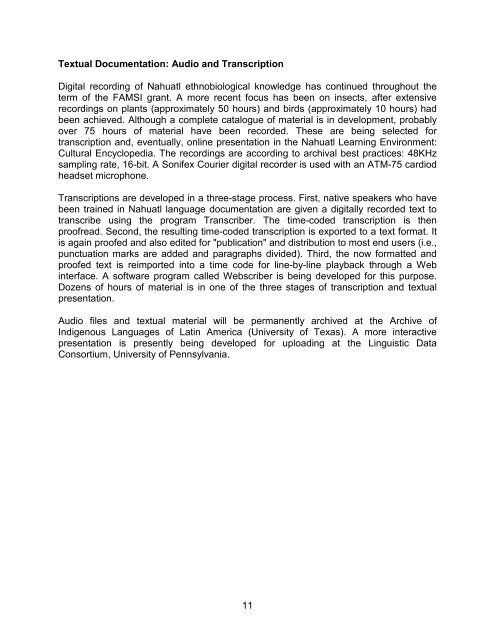Nahuatl Cultural Encyclopedia: Botany and Zoology, Balsas ... - Famsi
Nahuatl Cultural Encyclopedia: Botany and Zoology, Balsas ... - Famsi
Nahuatl Cultural Encyclopedia: Botany and Zoology, Balsas ... - Famsi
You also want an ePaper? Increase the reach of your titles
YUMPU automatically turns print PDFs into web optimized ePapers that Google loves.
Textual Documentation: Audio <strong>and</strong> Transcription<br />
Digital recording of <strong>Nahuatl</strong> ethnobiological knowledge has continued throughout the<br />
term of the FAMSI grant. A more recent focus has been on insects, after extensive<br />
recordings on plants (approximately 50 hours) <strong>and</strong> birds (approximately 10 hours) had<br />
been achieved. Although a complete catalogue of material is in development, probably<br />
over 75 hours of material have been recorded. These are being selected for<br />
transcription <strong>and</strong>, eventually, online presentation in the <strong>Nahuatl</strong> Learning Environment:<br />
<strong>Cultural</strong> <strong>Encyclopedia</strong>. The recordings are according to archival best practices: 48KHz<br />
sampling rate, 16-bit. A Sonifex Courier digital recorder is used with an ATM-75 cardiod<br />
headset microphone.<br />
Transcriptions are developed in a three-stage process. First, native speakers who have<br />
been trained in <strong>Nahuatl</strong> language documentation are given a digitally recorded text to<br />
transcribe using the program Transcriber. The time-coded transcription is then<br />
proofread. Second, the resulting time-coded transcription is exported to a text format. It<br />
is again proofed <strong>and</strong> also edited for "publication" <strong>and</strong> distribution to most end users (i.e.,<br />
punctuation marks are added <strong>and</strong> paragraphs divided). Third, the now formatted <strong>and</strong><br />
proofed text is reimported into a time code for line-by-line playback through a Web<br />
interface. A software program called Webscriber is being developed for this purpose.<br />
Dozens of hours of material is in one of the three stages of transcription <strong>and</strong> textual<br />
presentation.<br />
Audio files <strong>and</strong> textual material will be permanently archived at the Archive of<br />
Indigenous Languages of Latin America (University of Texas). A more interactive<br />
presentation is presently being developed for uploading at the Linguistic Data<br />
Consortium, University of Pennsylvania.<br />
11

















